“What would you be doing today if you only had 37 days to live?" By asking this simple but powerful question every morning, Patti Digh—an internationally recognized diversity expert and mother of two—transformed her life.
In October 2003, Patti Digh’s stepfather was diagnosed with lung cancer, dying just 37 days later. The timeframe scared her and woke her up. She started writing an “instruction manual for living” to leave behind for her two young daughters in case she died—guiding them, not in how to steam artichokes or find the lowest airfares, but how to live compassionate, full, regret-free lives.
What emerged are six practices for intentional living: Say Yes, Be Generous, Speak Up, Love More, Trust Yourself, and Slow Down, illustrated by 37 extraordinary and humorous life stories in LIFE IS A VERB: 37 Days to Wake Up, Be Mindful, and Live Intentionally. The book is inspiring, as well as a visual treat. As one reviewer put it, "Reading Life is a Verb is like mainlining goodness."
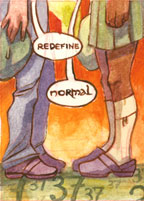
Patti has also dedicated her life to educating herself and others on the personal and societal costs of exclusion and discrimination. She is a co-author of Global Literacies: Lessons on Business Leadership and National Cultures and The Global Diversity Desk Reference, as well as the author of over 60 published articles on global business and diversity. As co-founder of The Circle Project, she works inside some of the biggest corporations in the world, helping them explore diversity and inclusion issues through stories and theatre.
(Illustration by Claire Hummel, www.shoomlah.com)
Patti and her husband, John Ptak, live in Asheville, North Carolina, with daughters Emma and Tess.
WOW: Your painful experience with your stepfather's passing just 37 days after his cancer diagnosis really strikes a chord. What insights emerged for you during that time?
Patti: We all know we’re going to die, even though we “rage, rage against the dying of the light,” as poet Dylan Thomas wrote. Being there with him as he died, I grew to appreciate the interconnectedness of life and death. And yet, the time frame of 37 days really hit me. By the time he got to those 37 days, it was really too late for him to live the life he’d always wanted—he had to “make do” with what he had because he was so sick, so quickly. It scared me. I literally started asking myself this question every morning as I woke up: “What would I be doing today if I only had 37 days to live?” It was a question that changed my life.
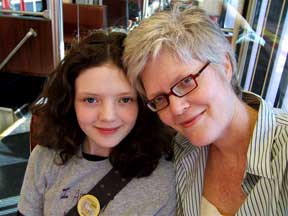
“I wanted them to know me as a human being, and not just as their mother.”
(Photo: Patti and her daughter Emma on a trolley in Tijuana)
WOW: You wrote the stories in Life is a Verb for your daughters, essentially creating a guidebook for living. What are some of the things you want them to know?
Patti: The answer to my 37 days question was that I needed to leave behind my stories—the tales of who I am, what I care about, what I messed up, what I worry about, what I love, what brings me joy—for my two daughters. And so, I started writing, framing each story to end with a challenge, to teach them something, to open up a line of questioning for them. I wanted them to know me as a human being, and not just as their mother. I wanted them to know that I had screwed up—and that they would too. I wanted them to gain insight into the bigger things of life beyond how to cook paste al dente. As the stories started gathering in one large pile, I realized that there were six actions I was really teaching them (and myself) about: how to say yes, be generous, speak up, love more, trust yourself, and slow down.
WOW: To capture everything you'd want your children to know seems like a daunting task, yet you seemed to have fun with it too. How did you approach the task of covering all of the bases?
Patti: Life, as it turns out, is incremental. I didn’t start with the end in mind—rather, I just started. I wrote just one essay every week, posting one every Monday for several years. I told people about it so there would be some external accountability to have an essay done each Monday—and that kept me honest and on track! I still haven’t captured everything for them—I think this will be a lifelong process for me. But what I do know is this—should I die tomorrow, I will have done what I needed to do for them. I will have left a bigger part of myself behind for them than just leaving my china collection or my set of grapefruit spoons.
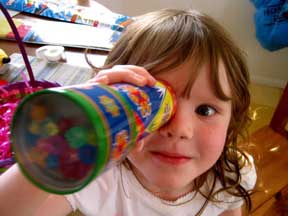
Excerpt:
37 Days: Do It Now Challenge
(Photo: Patti’s daughter, Tess)
Follow Tess’s lead and just wave. Just smile. Acknowledge the humanity of the people around you who don’t seem as human as you are—they are. If we turn away to remain safe, we can lose our own humanity. Engaging across these lines is messy sometimes—and sometimes it means being yelled at—but perhaps we need to get dirty once in a while. Just maybe, we should stop complaining about our own lives long enough to remedy our own brand of poverty and help others remedy theirs. As Mother Teresa said, “Hungry not only for bread—but hungry for love. Naked not only for clothing—but naked for human dignity and respect. Homeless not only for want of a room of bricks—but homeless because of rejection.”
Action:
Get out your journal for a focused free-write.
- Write for two minutes about your favorite childhood game. What was it, with whom did you play it? After two minutes, stop.
- Then write for two minutes about a secret hiding place, either now or from your childhood. Where was it? When and why do you go there? Stop.
- Write for two minutes about your greatest loss. Where did you feel that loss in your body? Stop.
- Write for two minutes about your first love. What sounds and colors and physical sensations do you associate with that experience? Stop.
- Write for two minutes about your dreams. What do you yearn for? Stop.
Read all you’ve written in this exercise. Now imagine that every other human being you will ever meet has the same richness and texture of experience and memory and story as you do—whether a ten-year-old boy or a university professor or a person in a homeless shelter or the janitor in your workplace. We are all complex, textured, layered beings—all of us. This is true of every single person we meet.
WOW: Your girls are so lucky to have this gift from you. It's also encouraging that you just started writing, without worrying too much about the giant assignment you'd given yourself. As I understand it, your blog came before the book. Could you talk about the blog's connection to the book's creation? Do you recommend that aspiring authors blog about their topic first?
Patti: I started a blog for all the wrong reasons—I just needed a place to keep some of my writing! I wasn’t “into” blogging, so I didn’t understand (or care) about the “best practices” for blogging, which completely freed me up to just write. I think we need to write because we need to write, not because we need more readers or page views. There’s so much attention in the blogosphere on measuring success—this is death to a writer.
I started posting one 2,000 word essay every Monday, breaking two cardinal rules for bloggers: First, that blog pieces must be short, and secondly, that you must post often. Because my intention wasn’t focused on success in blog world, I didn’t care. And yet, many people came to find 37days online—over 15,000 in the first 6 months—and came to find themselves in it, regardless of the fact that it wasn’t a typical blog.
I still don’t play the blogging game—that’s not why I’m writing. If I pay attention to readership, I lose focus on my own intention. When bloggers write to ask my secret for having such a successful blog, I tell them that they must first long to say something. I believe 37days is successful because I had one single intention and that is all. My intention wasn’t split between writing for my daughters and gaining a readership. No, it was one single intention—the greatest example in my life of the power of a compelling intention.
It turns out that a woman named Nikki Hardin was reading my blog and asked if I would be interested in creating a book from it. She is the publisher of Skirt! magazine and had just created a new book imprint in partnership with Globe Pequot Press, and the rest, as they say, is history!
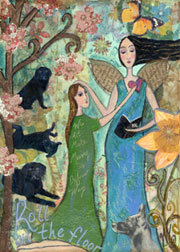
“I called the publisher to suggest that we ask 37days readers to illustrate the book, rather than a designer who didn’t feel as connected to the work.”
(Illustration by Wyanne Thompson, www.wyanne.com)
WOW: That's a great story! You've given bloggers a lot to think about too. Readers of your book will be struck by the beautiful design and artwork. Tell us the background behind the colorful illustrations.
Patti: One day, just two weeks from the final manuscript due date, I got an email from a woman named Donna B. Miller, who loved one of my essays and said she had created an Artist Trading Card to remind her of the essay—something she could keep in her wallet. She attached a copy of the card to her email, in case I wanted to see it. I printed it out and ran to the grocery store where I finally looked at it in the parking lot. It was extraordinary.
I called the publisher to suggest that we ask 37days readers to illustrate the book, rather than a designer who didn’t feel as connected to the work. They agreed to see what might be submitted, but honestly, I didn’t hold out much hope.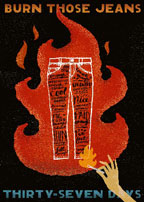 Whatever art would be submitted had to be done in the next two weeks—which was over Thanksgiving. I honestly didn’t think anyone would respond, but readers responded in droves, asking for essays to read and illustrate.
Whatever art would be submitted had to be done in the next two weeks—which was over Thanksgiving. I honestly didn’t think anyone would respond, but readers responded in droves, asking for essays to read and illustrate.
In the end, it was like an artistic barn-raising, with over 125 gorgeous pieces of art flowing in before the deadline. The publisher took one look at it and said not only would they change their plans and print in full color, but they would also include every single piece of art submitted. And that accounts for the gorgeous art at every turn in the book. It is truly a piece of art.
(Illustration by Jim Slatton)
WOW: It certainly makes for a beautiful book! What an amazing experience, having your readers provide the illustrations. What kind of art do you personally enjoy doing?
Patti: I love doing Polaroid image transfers and manipulating photo images, not digitally but physically. I used to go to Penland School of Crafts every summer and take photo classes or bookbinding or letterpress printing classes. Art that centers around typography is a particular interest—I nearly drove my publisher crazy asking for one of my favorite typefaces to be used for the text (Filosofia). And textiles are another favorite—I love textiles.
WOW: That all sounds like fun. In one of the stories in Life is a Verb, you say that being around your young daughter is like "getting a Ph.D in exuberance." As adults, how can we get back to a feeling of astonishment and an appreciation for ordinary things?
Patti: I think in order to reclaim awe, we have to give up caring too awfully much about what other people think of us. Sometimes we hide our exuberance because we fear we might look naïve or foolish. I would scream with joy at seeing the ice cream truck, but you’d make a note in my personnel file. I was in Madison, Wisconsin, recently for a book reading and my host, Jodi Cohen, took me with her to sing for Jewish services at a senior citizen center. The speaker talked about the Ten Days of Awe that those of the Jewish faith were celebrating at the time. “The first time something remarkable happens,” she said, “we call it a miracle. But when it continues to happen, we just call it ordinary.” I think we can get back to seeing things as a miracle if we give up wondering or caring how others will perceive us.
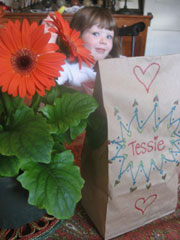
“I do try to erase the line between life and art to make them the same. The more mundane the better. We are at our most potent at our most ordinary.”
(Photo: Tessie and her lunch)
WOW: That's true, and something many of us probably need to practice. On a similar note, what are some ways we can incorporate artfulness into our daily routines? You have some good examples in the book.
Patti: I try to never put a plate on the table for my kids that doesn’t have some kind of design on it, so rice automatically gets stuffed into a small bowl and turned out upside down on the plate to become a snow mountain. Carrots and cucumbers become flowers when you place them on a plate in a certain design. Fruit plates are especially fun to shape into faces. Sometimes carrot sticks spell out names.
Bill-paying, for those few bills still paid by mail, is a great opportunity—print out some favorite quotes and brush watercolors over them for an instant piece of inspiration to include in your bill payment envelope. Include a small drawing in your child’s lunch box. Take a picture of your family every morning for a month—that’s art.
Am I Martha Stewart? Hardly. I can hear my friends laughing from here. But I do try to erase the line between life and art to make them the same. The more mundane the better. We are at our most potent at our most ordinary.
WOW: I love those ideas. At the end of the book, you give readers a final assignment—something we all should try, considering that life really is short. Can you share the assignment with our readers? Have you been working on it yourself?
Patti: At the end of my acknowledgments in the book, I urged readers to create a list of 20 people who have helped them in their lives and write one or two sentences capturing the gift they have received from them—to let those people know how they have been helped by them, before it’s too late. This is something I try to do on an ongoing basis, but I think we all take people for granted to some degree—and often it is the people closest to us that we forget to thank, isn’t it?
WOW: Yes, and we really should tell these people how much they are appreciated. On your blog, you had readers submit essays in response to the question, "What would I be doing today if I only had 37 days to live?" You received a lot of great responses from around the world. Were there common themes? Any ideas you particularly loved?
Patti: These are incredible essays—people are still submitting them, and I welcome people to submit their answers to me by email to patti@pattidigh.com, so we can continue this worldwide conversation about living life fully. Some people wanted to change their lives completely, to see the world, or quit their jobs. And some were content that they are living the life they had intended. In both cases, and overwhelmingly, what came through in these remarkable lyrical statements was the value of relationship and love. At the end of it, we are left with love. Who are those human survival units who will be at your bedside when you are dying? And how do you honor them while you are alive?
WOW: Those questions are profound. You've given us lot to think about. Since publishing the book, have additional lessons or ideas come up that you want to share with your daughters?
Patti: Definitely! I’m continuing to write an essay every week at 37days.com and more stories and challenges appear to me daily. I know I say that I’m teaching my daughters, but this process of looking at life so intently is actually teaching me far more. As are my daughters. They are my best teachers.
WOW: It's clear how much you love to spend time with your girls, which leads me to my next question. As a busy parent with various professional commitments, what are some of the ways you fit writing into your life? Can you share some of your writing routines?
Patti: I think we believe in order to be creative, we must have free reign, no holds barred, open space, and time without restrictions. But I’ve come to know that creativity actually needs structure. That seems paradoxical, perhaps, but I believe that from imposed structure comes great creativity. And so, the structure I’ve set for myself is to complete one essay each week by Monday. In such a way, I give myself the opportunity to really play with the language of that one essay for seven days, and in so playing, the meaning emerges. These essays are never what I believe they will be when I first draft them. The thinking and editing that I am able to do in that week shapes them, sometimes, into something completely different.
By having that structure, also, I have a deep sense of accomplishment every Monday, which I think is really necessary for writers. As someone once said, being a writer is easy—you just wait for drops of blood to form on your forehead.
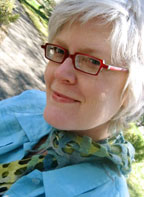
“Mainly, I’m trying to teach that we all see and judge other people’s outsides from our insides—and that has an impact on how we are in the world, with each other.”
WOW: I like how you say that an essay's "meaning emerges" because it's crucial to just start writing, and let yourself see where it takes you. Patti, you've written two business books on global leadership and diversity, one named a Fortune magazine "best business book for 2000." You've also developed diversity strategies and educational programming for major nonprofit and corporate organizations, and have been a featured speaker at many national and international conferences. What are some of the messages that you're trying to get across to people and organizations?
Patti: My work in the world has been in service to understanding, deepening, and healing relationships across differences. So, my business books and diversity work have centered on helping people—as individuals and in groups, whether communities or corporations—understand the difficulties of being in relationship across differences of all kinds, and teaching them practices for connecting and working together in healthier, more creative ways. I might engage with a group to help them understand the impact of culture on their business, for example, or to teach practices for being a more inclusive leader. Mainly, I’m trying to teach that we all see and judge other people’s outsides from our insides—and that has an impact on how we are in the world, with each other.
WOW: You are also the co-founder of The Circle Project, which helps organizations explore diversity and inclusion issues through theatre and story. This endeavor must be incredibly rewarding. What have been some of your most personally fulfilling moments with this project?
Patti: My business partner, David Robinson, and I are doing transformational work in the world. Each engagement we have with a client—a nonprofit, a school system, a corporation, a community—leaves us changed in some way, and transforms the way that group is with one other. That feels incredible, to know that we are doing powerful, elegant work. We have worked with top-level corporate executives, getting them into relationship in significant ways. To see a CEO and a janitor engaged and laughing and telling stories of who they each are—that’s potent, powerful work. Opening the space for each person in a group to be fully human, then helping them navigate the spaces between—that’s our work in the world.
WOW: Switching gears now, as a haiku lover, I think it's great that you write haiku book reviews. What a fun way to summarize the books you've read. How did you start doing this?
Patti: I love Haiku, too, and I was challenged to see if I could capture the essence of a book in a few syllables. I also tend to forget sometimes what I read, so it’s a great mnemonic device, too. It’s great fun to do! Dan Pink, author of A Whole New Mind, wrote to thank me for the Haiku review I did of his book, saying I got it right:
Left brain and right brain
which side is most important?
the artsy side wins.
WOW: Love it! Thank you so much for taking the time to chat with us today. Do you have any parting words of advice to share with our women writers/readers?
Patti: Pay attention to how you minimize your efforts. My business partner, not too long ago, asked me why I never say I’m a writer when people ask me what I do. “But I’m not a writer,” I said. “Not really.”
“Patti, how many books and articles have you written?” he asked. “When will you be a writer, if that doesn’t make you a writer?”
We had lunch a few days later with someone who turned to me at the beginning of the meal and said, “Patti, what do you do?” David cut his eyes over at me.
I turned smugly to answer, “I’m a writer,” I said, smiling.
“And what do you write?” the man asked in response. “Oh, I just write little essays every Monday,” I said.
We minimize ourselves in significant ways. Watch your language—I’m just an artist. I’m just a stay-at-home mom. I do little paintings. I just write little essays every Monday.
There are only three requirements for being a writer. The first is that you long to say something (even if you don’t know what it is yet). The second is that you actually sit down and write, and the third is that you want to write more than you want to be a writer.
WOW: That's a powerful story. Thank you, Patti for a wonderful interview, and best of luck with your new book!
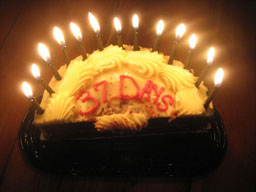
For more information about Patti, visit her web sites:
37days blog – www.37days.com
Life is a Verb info – www.pattidigh.com
Follow her on Twitter: @pattidigh
Join the 37days Facebook group!
Get a copy of her latest book: LIFE IS A VERB: 37days to Wake Up, Be Mindful, and Live Intentionally.
To listen to an audio file that tells the story behind 37days in a little over 2 minutes: https://37days.typepad.com/Verb.m4a
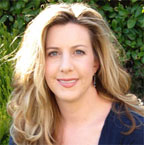
MARCIA PETERSON is a columnist for WOW! Women on Writing and Premium-Green (The Women's Guide to Freelance Writing and Markets). Her writing awards includefirst prize in the SouthWest Writers International Monthly Writing Competition and first prize in ByLine magazine's short article contest. She lives in Northern California with her husband and two children.